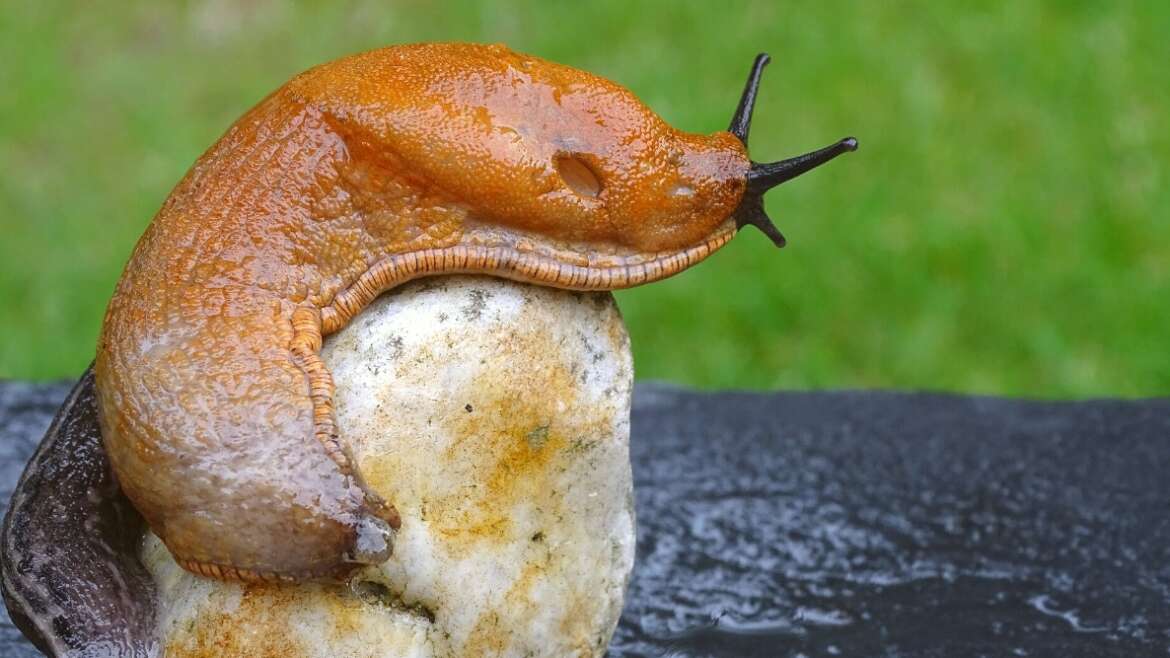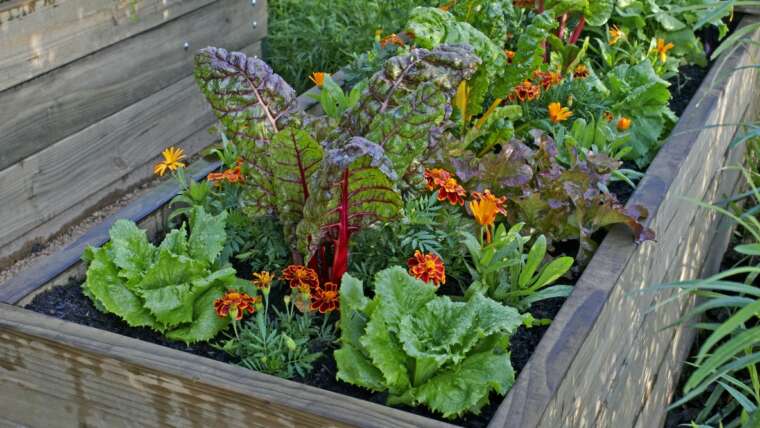Slugs are a common garden pest that can cause lots of damage in a short amount of time. They thrive in wet conditions and wreak havoc while you sleep. There are many wild and sometimes misleading ideas for trapping and killing slugs, including bait, eggshells, copper, and lettuce, but what about beer?
Is it an old wives’ tale that you can trap slugs with beer, or is it a reliable method? Let’s find out.
The Short Answer
The short answer is, yes, you can trap slugs with beer. Turns out they love a Friday night at the bar as much as the next guy. Let’s learn a bit more about them before we dive into how to set up a slug bar in your backyard.
What Are Slugs?
Slugs are slimy mollusks that hide in wet debris and lay up to 500 eggs.
Slugs are slender-bodied, slimy mollusks whose bodies stretch out as they slide along their path. Unlike snails, they don’t have shells. They can be up to 1 ½ inches long at full maturity or while in motion. Evidence of their presence can be seen from the slime they leave behind them. Their bodies also have a layer of slime, protecting them from drying out. They love hiding in wet garden debris and under stray boards and equipment.
They feature both male and female reproductive parts, allowing them to mate with any other slug. This also means that all slugs can lay eggs once they mature. Mating occurs in the fall and spring, and eggs will be laid when conditions are just right, although some species self-fertilize. Slugs can lay up to 500 eggs in their short lifetime, about 40 at a time.
Inspect soil surfaces for their slimy egg clusters throughout the season. They are grayish-yellow, gelatinous, and erratically spaced and sized. Depending on your climate, several generations of slugs are possible during each season. The average life span of a slug is 6-12 months but sometimes reaches 18 months.
When conditions are dry and dangerous, juvenile and adult slugs will burrow into cracks and under debris to practice aestivation. Aestivation, similar to hibernation of bears, is a physiological response that allows them to survive without food for months until suitable conditions return.
What Damage Do They Cause?
 Control slugs to protect plants, as they feed indiscriminately, creating irregular holes with their radula.
Control slugs to protect plants, as they feed indiscriminately, creating irregular holes with their radula.
Unfortunately for us gardeners, slugs are not picky and will feed on just about anything we are growing, so keeping them under control is crucial. They create smooth-edged holes on soft plant material, typically preferring new transplants that are extra tender. The holes are irregular, proving slugs have an erratic feeding habit.
Slug mouthparts are called radula. They cause the irregularity of chew marks. Some plant damage is fine and doesn’t usually affect the plant’s overall health. However, if a large colony of slugs moves into an area of newly transplanted kale and lettuces, they don’t stand much chance against the slugs’ large appetites.
The Long Answer
Beer traps are a safe and effective way to trap slugs. Slugs are enticed by the smell of yeast in beer. When strategically placed in your garden, slugs will climb inside beer traps, get a little sloshy, and then can’t climb back out and meet their demise. You can make beer traps with a few household items and cheap beer.
How to Make a Beer Trap
 Make a beer trap with a container, beer, and lid, burying it at soil level.
Make a beer trap with a container, beer, and lid, burying it at soil level.
With just a few items you likely have lying around, you can make a simple beer trap.
Supplies needed:
- An empty container of yogurt or take-out food, including the lid
- Sharp scissors to trim the container down
- Beer
Process:
- Add about three inches of beer to the container and snap the lid on.
- Poke a hole in the lid about the size of a slug so they can crawl in.
- Bury the container at the soil level. The smell will attract slugs as they crawl along the surface. Hopefully, they’ll crawl right into your trap.
Alternatively, you can keep the lid off, creating a simple pool of beer for the slugs to bathe and drown in. Bury the container to about ¾ – 1 inch deep. Any less and you may trap beneficial ground dwellers. This method is usually easiest if you use a shallow but wide container with a lip, such as a pie tin, as the lip can be at soil level.
It’s unknown why sometimes slugs drown while other times they can successfully drink a little beer and crawl right out. Built-up tolerance, perhaps? We just don’t know.
Slugs don’t travel far from where they hatch, so place traps near the base of damaged plants throughout your garden. Check traps daily and empty them, adding fresh beer each evening or every few days.
Do Slugs Have a Beer Preference?
 Choose lagers or stouts with moderate yeast and sugar for effective slug traps.
Choose lagers or stouts with moderate yeast and sugar for effective slug traps.
You don’t have to be a beer connoisseur to determine the sugar and yeast content in a particular type of beer, which is what slugs are attracted to.
Simply put, lagers and stouts are believed to be the most appealing to slugs due to their moderate yeast and sugar levels and generally strong flavors. Select a beer by its aroma. You should be able to smell the yeast and its sweetness when you crack the bottle or can. Slugs prefer fresh beer, so replace it often for best success.
A Similar Alternative
 If beer is unavailable, make a yeast solution with water, sugar, flour, and yeast.
If beer is unavailable, make a yeast solution with water, sugar, flour, and yeast.
If you don’t have beer readily available and are in a pinch, you can make a solution using water, sugar, yeast, and flour.
Using a similar container to the one mentioned earlier, mix a teaspoon of sugar, a teaspoon of flour, and ½ teaspoon of dried yeast into a cup of water. Stir well to combine fully, ensuring that the sugar dissolves, then add the solution to the container and bury it as instructed above.
Studies show the active yeast in bread dough is an attractive or more attractive bait than beer for gastropods and will likely continue to be investigated as a trap method.
Potential Cons of Beer Traps
 Use beer traps cautiously and combine them with other slug-repelling methods for effective control.
Use beer traps cautiously and combine them with other slug-repelling methods for effective control.
Some gardeners fear putting beer out in their garden will attract more slugs to the area, similar to the fear of attracting more Japanese beetles with pheromone traps. As long as you check traps regularly and follow slug-repelling ideas, beer traps shouldn’t cause too much trouble.
Mixing in other slug-trapping methods is recommended so you’re not just relying on the beer traps. Sprinkling organic snail bait at the base of plants or installing copper mesh cuffs are popular methods. Take notes on what works in your garden. When conditions are favorable, slugs can feed all season long, so keeping them under control is vital to your garden’s success.
Attract Natural Predators
 Cultivate a natural garden ecosystem to attract slug predators like ground beetles, toads, and birds.
Cultivate a natural garden ecosystem to attract slug predators like ground beetles, toads, and birds.
Creating a healthy and natural ecosystem in your garden will provide the best overall results, including attracting natural predators for common garden pests. Pests will always find their way into gardens, but understanding how the life cycles of different inhabitants work should help you keep pest pressure down.
A few critters that love feeding on slugs include ground beetles, snakes, toads, chickens, ducks, and various types of wild birds. Here are a few ways you can naturally attract some of these to your garden to help with control:
Perennials like asparagus, rhubarb, and various herbs provide the perfect habitat. They also love composting piles.
Provide warm hiding places and fresh water, incorporate long grasses, or leave some areas of lawn longer to give them a place to safely wander.
Any crevices or objects like logs, large rocks, and boards will provide toads ample hiding spaces. They’ll also hang out under a canopy of bushy lettuce and green beans.
As far as chickens and ducks go, allow them to feed on slugs in your garden at your own risk. Slugs may carry gapeworms, a parasitic nematode that latches onto the tracheas of birds, inhibiting their ability to breathe and sometimes leading to death. I’ve had backyard chickens, and I’m certain they’ve fed on slugs before and never encountered this issue. However, it’s possible, so just be aware of your flock grazing in your garden.
You can also place plants believed to repel slugs around your garden, such as rosemary, fennel, and anise. Colloquial reports indicate they are believed to naturally repel them with their strong scent.
Tips to Keep Slugs Away
- Clean up garden debris, effectively removing hiding places. This is especially important in the fall to remove any slug eggs hoping to overwinter in debris.
- Keep plants well-trimmed, removing unnecessary lower leaves and branches.
- Scout for eggs and damage, paying close attention to mulched areas.
- Deep water plants to decrease moisture on the soil surface and foliage and do so in the morning as often as possible to give plants a chance to dry out before the evening.
- Take action early. Handpick if necessary.
- Provide plants with ample airflow and sunlight to dry out excess moisture and add compost to the soil to help with drainage.
- Attract those natural predators.
- Use traps when necessary and mix different slug-trapping techniques for the best results.
Final Thoughts
Slugs are an important part of the food chain, but protecting your garden against them is crucial. Beer can certainly be used to trap and kill them, but if you’re worried about attracting even more slugs to your garden, focus on attracting natural predators to keep the circle of life turning and let nature do some of the work!




